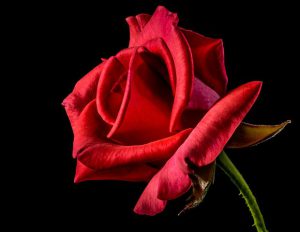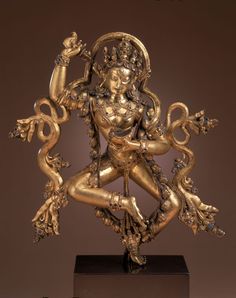Friday
Dharma TeachingsGreat Clouds of Blessings 2
A continuation of comments on A Supplication for Magnetizing the Phenomenal World
by Russell Rodgers
Some of the deities that arise in the next section of the chant are familiar to senior practitioners. Vajravarahi is also known as Vajrayogini. Padmaraja is an aspect of Padmasambhava. Kurukulla is another name for the Padmadakini, who is part of the retinue of Vajrayogini. The rest of her retinue, just for general background, are connected with the buddha families of vajra/intellect, ratna/enriching, and karma/activity. Lately the Sakyong has been giving Kurukulla empowerments, because he believes our sangha needs to develop magnetizing energy to accomplish our goal of creating enlightened society.
Within the great equality of appearance-emptiness / Swaying the three worlds with the dance of vajra body….Appearances, in all their variety, share one characteristic in common: they appear as images in the mind and they are all empty of what they are commonly taken to represent. Because they share this emptiness, they are said to be “one taste” in great equality. We can further examine the words appearance- emptiness using the logic of brain science: In this model, electrical impulses travel from the sense organs to the brain where images are formed. Within the mind, they are just images, appearance-emptiness, that we mistake for a world “out there”.
Two of the three worlds referred to in the chant are the invisible realms of the form and formless gods. The third realm is the desire realm, which is populated by humans and other beings that are visible to us. Since we are part of the desire realm, we constantly on the lookout for nice things, nice people, and pleasant surroundings. For us, desire manifests as a kind of fickle pickiness.
The word vajra means “indestructible,” therefore vajra body means “indestructible body.” To see how a body could be indestructible, we have to go back to how bodies manifest in the mind. Mind is empty like space, and is sometimes referred to as the “great expanse.” Unlike physical space, this mind is expressive: it is luminous and can manifest anything that we experience. Even though the ordinary body can be destroyed, the basic luminosity-emptiness of the mind that gave rise to the appearance can’t be destroyed. Emptiness can’t be destroyed: it’s already empty. Therefore this aspect of body is vajra, indestructible. It remains steady, even though its manifestation changes constantly.
You bestow the two siddhis—supreme among all that we desire. Firstly, there are the ordinary siddhis, like being able to purchase and pay for a building to house a Shambhala Centre. The supreme siddhis manifest as being one with the ultimate nature of things. Supreme siddhis are connected with compassion and transcendent knowledge.
 Pervading all of samsara and nirvana with red light rays…. The color of padma is a soft red, delicate and alluring. We could think of the red valentines that school children used to send, or the delicate petals of a pink or red rose.
Pervading all of samsara and nirvana with red light rays…. The color of padma is a soft red, delicate and alluring. We could think of the red valentines that school children used to send, or the delicate petals of a pink or red rose.
With great iron hooks and lassoes ….Kurukulla, as the quintessential magnetizing principle, has a bow made of flowers. She shoots arrows also made of flowers. If for some strange reason you wanted to resist her, she has a lasso and a hook, also made of flowers, for ensnaring you and making sure that you don’t want to get away. (In this chant the hook is made of iron, but traditionally it’s made of flowers. Probably the sense of iron here is that it is very strong.)
Hosts of magnetizing deities of the infinite three roots…..The three roots are the gurus, the protectors, and the deities. The gurus are the human conduits who enable us to glimpse the ultimate nature. The protectors are the forces of reality itself that give feedback when we are deluded. The third root are the visualized deities that enable us to connect to energies and aspects of mind that would otherwise be too subtle for ordinary people to experience. They are called roots, because they are the roots of our path to realization.
In the end, what do we want from this chant? When you chant through it, let the images arise and cease in your mind, and pay attention to the overall quality that remains atmospherically in your awareness. Perhaps, metaphorically, you might describe it as having a slightly reddish hue, delicate and oddly soft and enticing. Maybe that is the presence of the magnetizing deities. Maybe that energy will help us to magnetize what we desire for the benefit of others.
 Russell Rodgers has been wondering about this kind of topic for the 39 years that he has been practicing. He resides in the Kootenay mountains of British Columbia, in the town of Nelson, and has graciously agreed to allow publication of his beautiful essays on the Shambhala chants here in the Times.
Russell Rodgers has been wondering about this kind of topic for the 39 years that he has been practicing. He resides in the Kootenay mountains of British Columbia, in the town of Nelson, and has graciously agreed to allow publication of his beautiful essays on the Shambhala chants here in the Times.






Sep 29, 2017
Reply
Dear Roger,
I appreciate so very much the directness and generosity of your explanation. As a storyteller, working with image and the space between teller and listener where image arises unfixed in space, ephemeral and vivid, I am more and more interested in taking in the references, descriptions and recognition of how awareness of form-emptiness invigorates and loosens the mind from fixation. I need to contemplate more fully.Laura
Sep 29, 2017
Reply
Always greatly appreciate Russell’s comments, which make the complex and obscure easily clear and lucid. This will always be necessary. Many thanks.